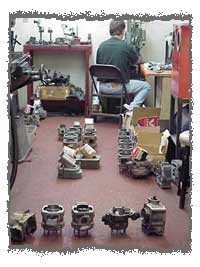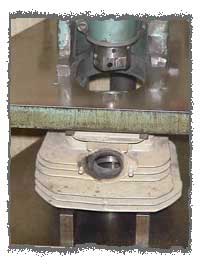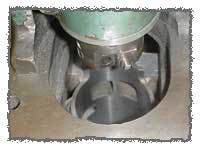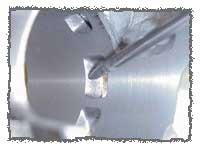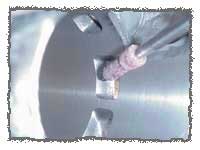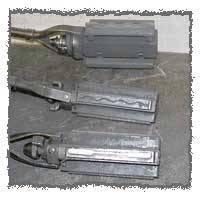Cylinder Boring – How is it done?
Cylinder Boring
By Rick Ritter
Cylinder boring – everyone who has an ATV knows what this term means, but did you ever wonder exactly what happens to your cylinder between the time you drop it off and the time you pick it up? What I am going to show in this article are the steps and procedures for doing this critical job correctly.
Here we are all set up to run some cylinders through the first step in boring a cylinder. After the upper and lower gasket surfaces are cleaned we are ready to go.
The cutting tip spins in the holder and automatically feeds itself down into the bore cutting a perfectly round hole parallel to the cylinder base. The bore is taken to within two thoundandths or so of the finished bore size using this machine. Most shops will be happy to show you their boring equipment if they have it. If all they show you is a hone, take your cylinder elsewhere. Removing large amounts of material with a hone can get the bore out of square – not cool.
|
Rotary Burr |
Sandroll |
|
Chamfering Ports. On two-stroke cylinders it is necessary to chamfer the port edges. Rounding of the sharp edge prevents premature wear on the piston and ring assembly. Using a rotary burr to make the initial chamfer, and finishing it out with a sandroll, is a good way to get the proper angle and finish. |
|
Honing Tools.
What you see in this photo are cylinder hones. Most of you have seen the “spring loaded paddle hones,” these are much different . These hones adjust by a screw that allows the operator to add tension as needed. Unlike a spring loaded hone, they will only cut a round circle if used properly. The cylinder’s final finish and size are attained using these pieces of equipment.
The fine stones that are doing the finish work will also imbed their abrasive into the cast iron walls of the cylinder. After picking up your cylinder from getting a fresh bore job, always wash your cylinder in hot soapy water. Washing in a solvent tank won’t get the abrasives out! Dawn dishwashing liquid works great for the final cleaning of a freshly bored and honed cylinder. After you clean and rinse the cylinder, dry it quickly and then get a clean white paper towel with oil on it and use it to lubricate the bore. If the towel comes out of the cylinder, when you’re done lubricating it, with any traces of black or gray then the cylinder needs to be cleaned yet again. When properly cleaned the white paper towel with the oil on it will look the same color on removal as it did when you put it into the bore.
You are now ready to install your new piston into the cylinder and get back to riding!
Thanks for taking the time to read this article. Maybe next time we can modify a 2-stroke cylinder head.
Rick
Editor’s Note: Rick Ritter is an expert engine builder and offers a variety of services and performance parts. Visit Rick’s web site at www.rittercycle.com

